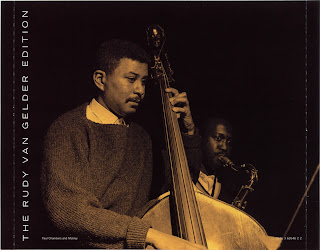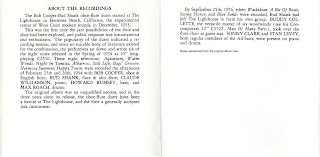HARD
BOP ORIGINS:
THE
LABELS: BLUE NOTE – Part 1
Calvin H. Neal, Jr.
July 9, 2017
During
the hard bop era a handful of labels from coast to coast were instrumental in
not only the proliferation of hard bop, but the home to some of the greatest
jazz artists in history and some of the best jazz ever recorded. Blue Note was
the bastion of hard bop and virtually all the stars of the genre recorded
there. Upcoming articles will discuss other labels including, Prestige,
Contemporary, Riverside, Impulse, Verve and Pacific Jazz.
A
love of American jazz, “hot music”, as he called it, was an integral part of
the immigration of German Alfred Lion in the 1930’s to NYC. Fresh on the heels
of John Hammond’s From Spiritual to Swing
concert in December 1938, Lion with financial backing from writer/activist
Max Margulis, rented a studio at WMGM Radio station in New York, plied Albert
Ammons and Meade Lux Lewis with bourbon and got them to play that boogie woogie
that Lion loved while he recorded the session. Blue Note was born on January 6,
1939. During its gradual rise to the top, Blue Note recorded Miles Davis, Lou
Donaldson, Herbie Nichols and the mercurial genius of Thelonious Monk among
others major stars. The February 1954 live recording of Art Blakey’s quintet at
the famed Birdland club which included the young, incendiary trumpeter Clifford
Brown, alto saxophonist Lou Donaldson and pianist Horace Silver harkened the
new sound that was on the horizon. This recording is historically significant
because it is a precursor of the hard bop genre and the fact that Clifford Brown
is seemingly encouraging his bandmattes to join him with his “new sound” plus
Brown went on with drummer Max Roach to be the first true exponents of hard
bop.
`
During
the prime years of hard bop, the best of the music could be found at Blue Note.
Art Blakey, Horace Silver, Lee Morgan, Jimmy Smith, Lou Donaldson, Jackie
McLean and the list goes on. Blue Note excelled in this era in many ways. Each
and every session was an all star session with a leader who, along with Alfred
Lion, picks his sidemen from Blue Note’s vast array of stars, the recording
wizardry of engineer Rudy Van Gelder who gave the label its signature sound to
the artistically cutting edge album cover designs of Reid Miles, Blue Note was
in a class of its own.
For
all the well known artists on Blue Note, some of these artists have been almost
forgotten in many cases, so I’d like to give you a brief glimpse at some of
hard bops’ forgotten heroes.
Henry
“Hank” Mobley was born July 7, 1930 in Eastman, Georgia, but raised in Elizabeth,
New Jersey. Mobley played in local RnB bands in the Newark, New Jersey area
until being tapped by Max Roach to join his quintet in 1951. By 1955, he was
leading his own sessions for Blue Note. Mobley recorded exclusively for Blue
Note from 1957-1970, recording 27 sessions as a leader.
Two
of Mobley’s more classic sessions were recorded at Rudy Van Gelder’s Englewood
Cliffs, NJ studios in 1961 for Blue Note. On March 26 Mobley led a quintet
featuring guitarist Grant Green, and two thirds of the (then) current and one
third former rhythm section of Miles Davis in pianist Wynton Kelly, bassist
Paul Chambers and legendary drummer Philly Joe Jones. On Workout Mobley and his cohorts acquit themselves very nicely. On
four Mobley originals and the standards, The
Best Things In Life Are Free and Three
Coins In A Fountain comprise this recording. The Mobley penned title track
and Greasin Easy are standout Mobley
compositions. Though Mobley is showcased and shines brightly, Green and Kelly
make their presences known. Mobley came back with the same group, sans Green,
on December 12 and recorded a follow up to April’s session. On Another Workout the quartet is firing on
all cylinders. Another mix of Mobley originals and standards include a tender reading
of the Stordahl, Weston, Cahn classic I
Should Care and Hank’s Other Soul and
Gettin & Jettin highlight the
Mobley originals. Here, Mobley and Kelly are definitely the stars. Other
notable Mobley sessions include Hank
Mobley Quintet (1957), Roll Call (1960),
Soul Station (1960), A Caddy For Daddy (1965) and Third Season (1967). Mosaic have has put
together a collection, The Complete Blue
Note Hank Mobley Fifties Sessions, a six cd set that features Mobley’s nine
Blue Note sessions from the 1950’s, that is very easily recommended.
Harold “Tina” Brooks was born in
Fayetteville, North Carolina June 7, 1932. In sessions with Blue Note as
sideman for Jimmy Smith, Freddie Hubbard and Freddie Redd, or in his own Blue
Note session featuring Jackie McLean, Blue Mitchell and Kenny Drew, Brooks’
hearty, soulful sound, featuring characteristic quotes, along with his success
as a composer, leave Brooks one of the truly forgotten heroes of hard bop.
Threats from bullies as a youth due his small stature, the nickname ‘Tina’ is a
derivation of the original nickname of ‘Teeny’ because of his small size,
Brooks left his native North Carolina as a teen to live with relatives in New
York. After high school, Brooks played with Joe Morris, Charles Brown and Amos
Milburn, even having “a cup of coffee” with Lionel Hampton’s band. In the Bronx
in 1958, Brooks was playing at The Blue Morocco with
Harlem trumpeter “Little”
Benny Harris. It was Harris who suggested Brooks to Alfred Lion and before you
know it, Brooks was signed to Blue Note and playing on Jimmy Smith’s sessions
that led to The Sermon, House Party and Confirmation, recorded August 25, 1957 and February 25, 1958 at
NYC’s Manhattan Towers studio. Brooks led four Blue Note sessions, Minor Move, recorded March 13, 1958, True Blue, June 25, 1960, Back To the Tracks, September 1 &
October 1960 and The Waiting Game from
March 2, 1961. The September 1 session also led to the recording of a joint
venture from Brooks and Jackie McLean, Street
Singer, another Blue Note classic not released until 19 years after its
recording. Brooks, also a very accomplished composer, wrote the title track,
Open Sesame, and the exotic Gypsy Blue from Freddie Hubbard’s Blue
Note debut recorded June 19, 1960. Sadly, True
Blue was the only of Brooks’ leader dates released during his lifetime.
On 1960’s True Blue, Brooks is joined by 22-year old trumpet rising star
Freddie Hubbard, bebop veteran pianist Duke Jordan, bassist Sam Jones and
drummer Arthur Taylor. With five Brooks’s originals and Jack Segal and Marvin
Fisher’s standard, Nothing Ever Changes
My Love for You, the quintet is in excellent form. On the title track
Brooks displays his signature full, warm inviting sound. Hubbard is fresh,
lyrical and strong, while Jordan exhibits his light and elegant touch. On Theme For Doris, with its samba like
refrain Brooks’ tone is cool and well stated and his feisty solo features his
signature honks. True Blue should be
recognized as the hard bop anthem it is. Its twisty intro leads to a strong
statement from Brooks. Hubbard’s fiery solo is a very good indicator of the
greatness to come. Jones and Taylor keep the beat on point throughout. Miss Hazel and Nothing Ever Changes My Love For You round out this highly
recommended Blue Note session.
Recorded only months after True Blue, Back To The Tracks finds
Brooks back in Rudy Van Gelder’s Englewood Cliffs studio. This time he was joined
by two frontline mates, alto saxophonist Jackie McLean and trumpeter Blue
Mitchell, who was then a member of Horace Silver’s quintet. On one of Brooks’
best compositions the gorgeous gives all front line men room to stretch out.
Tina is so laid back and in such a groove you can just see him in the smoky
studio, eyes closed, riffing. Blue Mitchell picks up where Brooks left off with
the groove and Mclean states briefly. The somewhat forgotten brilliance of
Kenny Drew shines before Paul Chambers “walks” us around the block. On For Heaven’s Sake, Brooks’ tenor is
tender and yearning while Mitchell offers, strong and somber. Brooks was
saddled with heroin addiction which exacerbated the end to his brief career,
but left a nice body of work as an endearing legacy. His work has been
documented in a wonderful set from Mosaic, The
Complete Blue Note Recordings of the Tina Brook Quintets. Though long out
of print, copies can be found and are worth the search.
Conrad Yeatis “Sonny” Clark a bop
influenced pianist who was a Blue Note regular in the early years of the era,
was born July 21, 1931 in the mining town of Herminie, Pennsylvania. At 19,
Clark moved to Los Angeles to live with relatives and began playing on the
local Los Angeles jazz scene. He recorded Wardell Gray, Teddy Charles and Frank
Rosolino. Clark was a member of clarinetist Buddy DeFranco’s group from
1953-56, then becoming a member of Howard Rumsey’s
Lighthouse
All-Stars. Tiring of the West Coast, Clark secured a position as accompanist to
Dinah Washington, as used her tour as passage back to New York. Joining Blue
Note in 1957, Clark was the pianist of choice for Blue Note in early years of
hard bop and recorded with Jackie McLean, Grant Green, Art Blakey and Stanley
Turrentine as well as many other Blue Note artists as leader and sideman on the
label. His two signature sessions are both hard bop classics. Cool Struttin’ was recorded January 5,
1958 in Rudy Van Gelder’s Hackensack, NJ studio and is one of the shining stars
of that year’s Blue Note releases. From the opening sounds of the bluesy Clark
composed title track, you know you are in for a treat. Clark’s bop inflected,
gospel tinge blues style, which is instantly recognizable is aided by trumpeter
Art Farmer, altoist Jackie McLean, Paul
Chambers on bass and Philly Joe Jones on drums. This star power is indicative
of the kind of line-ups you would find on Blue Note sessions. Miles Davis’ Sippin’ At Bells and two of the three
Clark penned compositions; Blue Minor and
Cool Struttin’ are hard bop gems and
compositions that should be revisited. On November 13, 1961 Clark visited Van
Gelder’s Englewood Cliff’s studio to record what his finest work is arguably. Leapin’
and Lopin’ opens with Somethin’
Special, a Clark original that really swings. Tenorist Charlie Rouse, then
in the early stages of his tenure with Thelonious Monk, opens strong and
lyrical. Tommy Turrentine, older brother of tenor sax man Stanley makes a strong
introduction on trumpet while Clark’s nimble touch is cooking. Butch Warren’s
bass and drummer Billy Higgins complete the quintet. Bop veteran and Blue Note
A & R man Ike Quebec replaces Rouse (only) for the Van Heusen/Delange
classic Deep In A Dream. Quebec’s full, warm sound compliments
Clark’s tenderness here. Another Clark composition Melody For C, is the session’s standout. Clark, Rouse and
Turrentine make this one of Clark’s most memorable tunes. Compositions by
Warren, Eric Walks and Turrentine, Midnight Mambo are highlights as well.































No comments:
Post a Comment